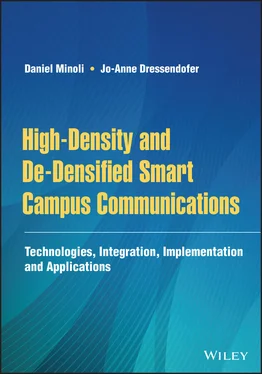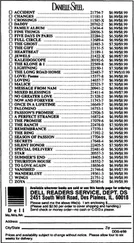1 ...8 9 10 12 13 14 ...23 New technological solutions are being developed to manage the increasingly scarce infrastructure resources, especially in view of the challenges imposed by population growth, limited financial resources, and perennial political inertia. IoT technologies and principles hold the promise of improving the resource management of many assets related to city life, including the flow of goods, the movement of private and public vehicles, and the greening of the environment. Smart Cities application areas include but are not limited to ITSs (including Smart Mobility, vehicular automation, and traffic control), smart grids, smart building, goods and products, logistics (including smart manufacturing), sensing (including crowdsensing and Smart Environments), surveillance/intelligence, and smart services. Cities have been incorporating new technologies over the years, but recently the rate of technology adoption has increased, especially for, but not limited to, surveillance, traffic control, energy efficiency, and street lighting. Many of these IoT technologies require extensive communication infrastructures supporting high density, low latency, and high reliability. For example, ITSs require end‐to‐end latency in the order of milliseconds as well as high density in congested locations. Dense residence neighborhoods require Gbps‐level user experienced data rate [2].
1.3 PANDEMIC‐DRIVEN SOCIAL DISTANCING
A novel coronavirus, Severe Acute Respiratory Syndrome Coronavirus 2 (SARS‐CoV‐2), was identified in December 2019 as the cause of respiratory illness and other morbidities and was designated Coronavirus Disease 2019, or Covid‐19.
The Covid‐19 pandemic was raging worldwide in 2020. Figure 1.5depicts illustrative infection and casualty data from the COVID‐19 Dashboard by the Center for Systems Science and Engineering (CSSE) at Johns Hopkins University (JHU), retrieved on 7 December 2020. Airline travel has been dramatically impacted; Figure 1.6is a personal photo at Newark Airport, 21 October 2020, at 1:09 p.m.
While medical solutions in the form of diagnostics, prophylactics, therapeutics, treatments, and vaccines were eagerly sought worldwide, two basic mechanisms have been adopted as preventive measures: mask‐wearing and social distancing. Social distancing has been applied to a large number of social settings, including work locations, schools, travel, sports events/arenas, entertainment events, church attendance, cruises, and political events, to list just a few.
Social distancing can be seen as being related to the concept of “social density,” which is defined in the field of Psychology as “density that can be changed by altering the number of individuals per given unit of space. Spatial density is density that can be changed by altering the amount of space while keeping the number of individuals constant.” Social density is a major determinant of crowding when individuals feel that the amount of space available to them is insufficient for their needs [26].
As regions stabilized from the COVID‐19 pandemic and stay‐at home and WFH restrictions were eased and/or lifted, firms sought to bring workers back into the physical workplace. Many organizations endeavored to institutionalize current best practices and protocols to facilitate an orderly return of tenants to buildings. While these measures do not necessarily guarantee the safety or protection from COVID‐19, they generally complied with current government regulations and also selectively adopted Industry Best Practices, including suggestions from the World Health Organization (WHO), the Center for Disease Control (CDC), the Building Owners and Managers Association (BOMA), as well as local Department of Health (DOH) (e.g. [27–46]). Practical considerations include:

FIGURE 1.5 Infection and casualty data from the COVID‐19 Dashboard by the Center for Systems Science and Engineering at Johns Hopkins University – As of 7 December 2020. At galleys review time (August 27, 2021) the total cases were 214,647,607 and the total deaths were 4,474,716 (Johns Hopkins COVID‐19 Dashboard).

FIGURE 1.6 Pandemic impact on airline travel in the Fall of 2020.
1 Preparing the site or building: cleaning plans, prereturn inspections, HVAC and Mechanical checks;
2 Control Access: protocols for safety and health checks, building reception, shipping, and receiving, elevators, visitor policies;Occupancy monitoring – building, tenants, visitors;Occupancy monitoring – utilization of escalators, elevators;Pre‐authorization coordination with tenants for tenant access (per day);Thermal scanning of visitors and staff.
3 Create a Social Distancing Plan: decreasing density, schedule management, office traffic patterns;Mask – Social Distancing Enforcement – tenants, visitors, maintenance staff, and servicing vendors;Floor markings – 6‐ft distancing;(IoT‐type) sensor deployment to monitor occupancy, bathroom use, air quality, wellness‐deployment options.
4 Reduce touch points and increase cleaning: open doors, clean desk policy, food plan, cleaning common areas.
In the work environment, social distancing takes the form of physical/desk distancing in support of OSD and ODCMA. A 6‐ft/2‐m goal becomes a defacto standard for a large number of venues. In addition, a number of firms have installed higher cubicle partitions, told employees to wear masks when not at their desks, and set up one‐way aisles in the office that force people to walk the long way around to get to the kitchen or the bathroom; other firms have instituted staggered shifts (e.g. half the staff comes in on Mondays, Wednesdays, and Fridays, the other half on Tuesdays and Thursdays), deployed spaced‐apart desks in open spaces, eliminated break rooms, placed sanitizer in many prominent office locations, and have been subjecting employees to daily questions about their health [47]. The “de‐densification” impacts many factors (e.g. policies, economics, profitability, occupancy, real estate utilization, sustainability). For example, as of late Summer 2020, a real estate trade group estimated the occupancy rate for many office towers in downtown Boston or New York at around 5–7%, and 10–30% in the suburbs. Of course, “de‐densification” also impacts network connectivity services and architectures; however, wireless technologies, including wireless sensor networks and the IoT, have been advantageously harvested to address and manage these pressing distancing issues (even contact tracing).
Real‐Time Location Systems (RTLSs) 4 are wireless systems employed to automatically identify and possibly track the location of objects or people in real time, within a building, or in other constrained or defined spaces (for example, in campuses, in wide‐area/regional spaces, or worldwide). These signals are typically electromagnetic: RF systems are common, but some systems use optical/infrared mechanisms (other signals can also be used in confined spaces). Position is derived by measurements of the physical properties of the radio link.
Automatic wireless monitoring is prevalent in a variety of industries, where location and other characteristics of a product or environment must be tightly monitored for safety or regulatory reasons, such as hospitals; other environmental parameters may be significant due to the nature of the items or processes (e.g. manufacturing processes) monitored. Factors such as humidity, exposure to light, motion sensors, positional location within a predetermined area, and orientation of the product (e.g. whether or not it is upright) may be important. RTLSs have thus gained popularity and are now seen as a “mainstream product” [48]; these systems are especially popular in the healthcare industry for applications ranging from asset tracking through patient and staff tracking, environmental or patient sensing (e.g. temperature), hygiene compliance, elopement (i.e. a patient leaving a facility without authorization), and theft prevention. They also have applications in de‐densification of the office for OSD/ODCMA use cases.
Читать дальше














